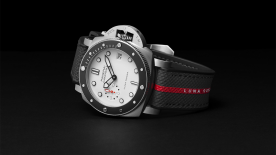Press release
Eterna KonTiki: from seafaring adventure to distinction on the wrist
The seaborne adventures of a young Norwegian who, in 1947, decided to demonstrate the validity of a historical and geographical hypothesis of his was to have consequences both unexpected and welcome for a watch manufacturer at the heart of the Swiss watch industry. They would later lead Eterna to issue a watch called KonTiki – the name of an Inca god – which gradually grew into a dynasty of sports, diving and dress watches. This year, the KonTiki Date takes centre stage.
In 1937, a newly married Thor Heyerdahl decided to extend his honeymoon on the Marquesas Islands, ideally located in the middle of the Pacific Ocean. The geography and zoology he had studied at the University of Oslo gradually led the young Norwegian to formulate a daring hypothesis. He came to suspect that the prevailing winds and maritime currents could have made possible the human colonisation of Polynesia by people from South America rather than from the continent of Asia. Furthermore, the name of an Inca sun-god, Kon-Tiki, seemed to appear in Polynesian religious myths.

From theory to practice
Ten years later, Thor Heyerdahl found himself in Callao, on Peru's Pacific coast, overseeing the construction of a balsawood raft similar to those known to have existed before the Spanish conquest. The budding explorer named it Kon-Tiki in salute to the Inca sun-god.
After rounding up sufficient financial backing, he and five other Scandinavians with varying scientific interests sailed from Callao on April 28 1947, with minimal supplies and a radio set. The six men relied on Pacific winds and currents to propel them all the way to Polynesia.
Strapped to his wrist, each Kon-Tiki crew member carried an Eterna timepiece, the contribution of one of the few watch manufacturers of the day to have truly mastered watchcase watertightness. An invaluable and remarkably sturdy navigation tool, their watch provided welcome accuracy and dependability. Very advanced for its day, the Eterna design was part of a limited series specially created for Heyerdahl's project.
After 101 adventurous days and nights, covering some 8,000 kilometres (4,320 nautical or 4,971 land miles), the voyage ended somewhat abruptly on the coral reefs of the Raroia atoll in the Tuamotu archipelago. The crew was fine, the raft a bit the worse for wear. The Eterna watches, for their part, were running as smoothly as ever, unaffected by water, moisture, salt corrosion and temperature variations. Back in Granges, Switzerland, Eterna's technical teams drew the appropriate conclusions.
From a legendary figure and name, Kon-Tiki would now become an exceptional horological dynasty.
On the wrist, the memento of a historic adventure
In 1958, the world discovered the self-winding Eterna Matic “KonTiki”, whose dial featured four luminescent triangles bearing hour figures. So efficient was its construction, water- resistant to 100 metres (328 feet, 10 bar), that a watch lost overboard and found by chance after two years underwater started running quite normally after a simple cleaning job. That same year, Eterna came out with a KonTiki for ladies featuring the same functions as the men's model and a calendar to boot!
Four years later, the Eterna Matic Super KonTiki with easy-to-read dial, rotating bezel and water-resistant to 200 metres (656 feet, 20 bar) provided divers with a superlative instrument for their sport or trade. It was followed in 1970 by the Eterna Sonic KonTiki that marked the onset of electronic precision in the company's product range. The underwater saga continued in 1973 with a Super KonTiki whose bracelet extension allowed the watch to be fitted over a diving suit.
In 1976 the Royal Quartz KonTiki in gold-enhanced stainless steel was the slimmest of all calendar-equipped watches of its day. Several variants of this design were produced over the years for a number of markets, starting with Italy in 1984.
1992: the KonTiki line took the plunge once again with the Eterna Matic 1856 KonTiki officially certified chronometer, water-resistant to 200 metres (656 feet, 20 bar), joined that same year by a strikingly handsome chronograph with tachymetric scale, featuring a self-winding certified chronometer movement. In 2004, the Eterna KonTiki Four-Hands revisited the design of the original KonTiki model, followed in 2006 by the launch of the strikingly original KonTiki Diver with a movement fitted inside a pivoting case, water-resistant to 1,000 metres (3,280 feet, 100 bar), clamped in a wrist frame strapped to the wrist.
In 2006, Eterna introduced the Eterna KonTiki Four-Hands XXL. Then, in 2008 the collection was joined by the KonTiki Chronograph, plus, the year after that, the KonTiki Date, featuring a calendar aperture between 4 and 5 o'clock on the dial. All these models naturally remain available today.
For a half-century now, the Eterna KonTiki watch dynasty is the choice of the sports-spirited and the style-conscious all over the world, in enduring salute to the daring and courage of Thor Heyerdahl and his companions.
The Eterna brand
Eterna has since 1856 manufactured high-quality mechanical timepieces born of traditional craftsmanship. Over its more than 150 years of existence, numerous major developments have emerged from the company's workshops. Revolutionary innovations such as the Eterna-Matic ball-bearing-mounted rotor and the first alarm-equipped wristwatch originated at Eterna. Other milestones include the recently developed spring barrel construction mounted on ball-bearings, the Eterna Spherodrive setting a new reference with respect to quality and longevity of a mechanical movement. As one of a few manufacturers, Eterna places value on new ideas and elaborate materials for its traditional craft. And it is by doing so that Eterna has succeeded time and time again in devising unexpected solutions to watchmaking challenges that had defied the centuries. Today one of the world's last remaining independent watchmaking companies, this traditional Swiss brand now belongs to Ferdinand Alexander Porsche. As a license partner, Eterna is responsible for the exclusive Porsche Design watch collection.
KonTiki Date – Technical specifications
Movement:
Sellita calibre SW 200; self-winding movement; power reserve 38 hrs; 28,800 v.p.h.; 26 jewels; 12½ lines; hours, minutes and seconds; date indication.
Dial/hands:
dial versions: black, blue or white with embossed Raroia atoll outline at centre; hour markers: rhodium-plated or blued baton-style hour markers with triangular hour markers featuring Arabic numerals at 3, 6, 9 and 12 o'clock coated with white luminous compound; rhodium-plated or blued centre hour and minute hands coated with white luminous compound; rhodium-plated or blued centre seconds hand with dot coated with white luminous compound and red tip; cambered, scratch-resistant, anti-reflective sapphire crystal
Case/back:
polished and satin-finished stainless steel case; screw-locked back with KonTiki medallion; screw-locked setting crown; water resistant to 200 m/ 656 feet/ 20 bar; diameter: 42.00 mm; thickness: 12.35 mm.
Bracelet/clasp:
Black or blue caoutchouc strap with polished and satin-finished stainless steel folding clasp.




